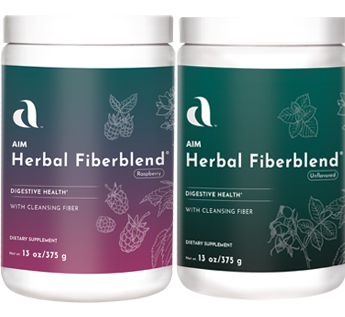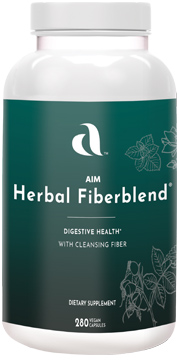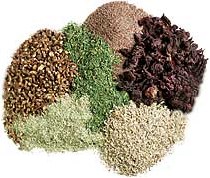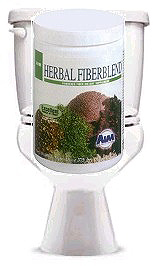|
Available in Capsules Too !!
  Herbal Fiberblend Herbal Fiberblend
 Herbal Fiberblend Herbal Fiberblend provides the fiber that is often lacking in our diets. Its combination of fiber and cleansing herbs provides the perfect way to keep your digestive system clean and maintain your digestive health. provides the fiber that is often lacking in our diets. Its combination of fiber and cleansing herbs provides the perfect way to keep your digestive system clean and maintain your digestive health.
Benefits & Features
Benefits
-
Helps maintain whole body health
-
Helps maintain digestive health
-
Helps maintain regular bowel movements
-
Detoxifies - removes toxins from the body
-
Reduces transit time - provides more thorough evacuation of waste
-
Fiber studies show that soluble fiber helps
maintain healthy cholesterol levels and may reduce incidences of
diverticulosis, colon cancer, and appendicitis
-
Water-soluble fiber helps maintain healthy cholesterol and blood sugar levels
Features
-
More than 10 years of safe and beneficial use by
AIM Members
-
Contains the soluble fiber psyllium and more than
15 cleansing herbs
-
Good source of fiber: 10 grams per 2 tablespoon
serving
-
13-oz Raspberry or 13-oz Unflavored
-
Now in 280 Veggie Capsules too!!
 Benefits of fiber
A variety of epidemiological (disease and population)
studies have found that in populations with high-fiber diets, the
incidences of colon cancer, appendicitis, and diverticulosis are very low.
Industrialized countries, which largely have diets high in fat and low in
fiber, have high incidences of these diseases.
Fiber has long been recognized as one of the best
food ingredients for maintaining regularity and preventing constipation.
Consuming fiber reduces transit time and results in a more thorough
evacuation of waste materials.
Because fiber may cause starches and sugars to be
absorbed more slowly into the bloodstream, the amount of glucose in the
blood is reduced and so is the work required of the pancreas in producing
insulin.
Water-soluble fiber may lower cholesterol. This is
because fiber removes bile acids from the body, and bile acids are made
from cholesterol. In order to replace the bile acids lost to fiber, the
body pulls more cholesterol out of the blood. This lowers cholesterol.
However, not all water-soluble fiber does this. The fiber found in oat
bran, legumes, and psyllium does. Studies reported by Kellogg indicate
that a daily intake of 10 grams of psyllium may lower cholesterol by as
much as 15 percent.
Because fiber is low in calories, it can be added to
your diet, providing a greater feeling of satiety without significantly
increasing your caloric intake. In other words, you may find yourself
eating less. This is beneficial in weight-loss programs.
Cleansing, detox, and herbs
The concept of body cleansing has been with us for
centuries; simply put, this means that various parts of the body must be
in harmony, and if they are not, sickness develops. This harmony was
traditionally achieved through diet, internal medicine, purging, vomiting,
bleeding, cupping, and other methods.
Today, many health practitioners recognize the
importance of keeping the body in harmony; it is often referred to as
cleansing or detoxification. Many health practitioners believe that this
is particularly important today, as our world is becoming increasingly
polluted with toxins found in the environment and in the foods we eat.
 Why cleanse?
Toxins undermine our health. Elson Haas, M.D., in his
book Staying Healthy with Nutrition, defines a toxin simply as "any
substance that creates irritating and/or harmful effects in the body,
undermining our health or stressing our biochemical or organ
functions." More specifically, a body overloaded with toxins can
result in a number of symptoms. These include constipation, stomach bloat,
poor digestion, gas, fatigue, weight gain, excessive mucus, poor
concentration, headaches, poor skin, poor memory, depression, body odor, and
bad breath.
Some health practitioners relate toxins to specific
diseases. R.A. Buist, M.D. (International Clinical Nutrition 8, no. 4
[1988]), states that chronic fatigue syndrome may be related to toxin
exposure. Multiple chemical sensitivity and fibromyalgia (muscle and joint
pain) may also be environment-related diseases. Indeed, there is a new
medical category, clinical ecology, which deals exclusively with how
toxins in the environment affect our health.
Cleansing
The body does have a system in place for detoxifying
these harmful toxins. The most important cleansing organ is the liver.
Eliminative channels include the bowels (the digestive system), kidneys,
skin, lungs, and lymphatic system.
When the body is doing its job, and is not
overburdened with toxins, the blood carries toxins to the liver, which
uses enzymes to detoxify the harmful substances. They are rendered
harmless or converted into a water-soluble form that is then eliminated
via the urine or feces. For a great enzyme product see PrepZymes.
Unfortunately, this system can handle only so many
toxins and was designed for "natural" toxins, not the man-made
ones we have to deal with today. For example, protection against an
age-old toxin-alcohol-is built into our genes. One gene codes an
enzyme to convert alcohol into substances that the body can use or
excrete.
Our body does not, however, always know how to handle
the new toxins in our lives. It cannot understand how to excrete them, and
they may accumulate to harmful quantities or be converted to odd, unknown
substances that can interfere with metabolism. According to the textbook
Nutrition, Concepts and Controversies, this can result in cancers or birth
defects.
Today, there are different ways to cleanse the body.
Among these are baths and hydrotherapy, diet and nutrition, herbs,
chelation, and exercise. Using herbal supplements, often in conjunction
with other methods, is one of the most popular ways to cleanse the body.
Herbs in cleansing

Herbs have been used for cleansing purposes for ages.
Herbs are said to promote cleansing by eliminating toxins from the organs
and systems of the body.
Two thousand to 3,000 years ago, herbal medicine was
practiced in both China and India. About 2,000 years ago, the earliest
Chinese pharmacopoeia, the Pen Tsao, appeared. It tried to give an
authoritative survey of the medicinal preparations available at the time.
In the West, in the first century a.d., the
pharmaceutical guide De Materia Medica was written by the Greek physician
Dioscorides. In it, he describes the use of more than 600 different herbs,
as well as 35 animal products and 90 minerals.
In the sixteenth century, the Swiss-born physician
Phillipus Aureolus Paracelsus began to stress the idea that the value of
plants is found in their chemical makeup. In other words, he invented the
idea of "active ingredients." Scientists began to isolate these
ingredients and create them in the laboratory.
Today, more than 25 percent of prescription drugs are
derived from plant sources. If you add species such as fungus and molds to
this, the number jumps to 50 percent.
Although there is much personal validation on the
benefits of herbs, and herbal medicines are prescribed in many countries,
there have been few clinical studies on herbs in North America. This is
changing, however. More information about herbs is coming from Europe,
more studies are being conducted on herbs in North America, and more and
more health practitioners are beginning to use herbs for cleansing and
other healthful purposes.
Herbal Fiberblend
Two tablespoons (14-16 g) of Herbal
Fiberblend contain 8 to 10 grams of fiber-most nutritionists recommend
25 to 40 grams of fiber a day.
Psyllium, which is the main fiber source in Herbal
Fiberblend, has over eight times the bulking power of oat bran.
Psyllium is approximately 75 to 80 percent dietary fiber, 60 to 70 percent
of which is soluble fiber. The herbs in Herbal
Fiberblend bring you powerful detoxification effects. Combined, these
herbs make Herbal Fiberblend one of
the most valuable fiber and herb products available today.
Herbal Fiberblend
is a professional formulation of herbs in a convenient, easy-to-use
powder. No grinding and mixing herbs yourself! It is available in unflavored, and raspberry flavors.
Ingredients
The ingredients in Herbal
Fiberblend work together to help your body help itself. Following are
the names of the herbal ingredients. Depending on the flavor, Herbal
Fiberblend also contains raspberry
flavoring, rose hips, or capsicum.
-
Alfalfa - Medicago sativa - Relieves constipation and reduces cholesterol
-
Black walnut hulls - Juglans nigra - Reduces intestinal parasites and improves bowel movement
-
Capsicum - (fruit) Promotes cleansing of the circulatory and digestive systems; regulates blood pressure
-
Cascara sagrada - Rhamnus purshiana - Acts as a laxative, stimulating evacuation from the bowels; promotes peristaltic action (muscular contractions in the digestive system)
-
Hibiscus flower - Hibiscus sabdariffa - Lubricates the intestinal tract
-
Irish moss - Chondrus crispus - Helps form bulky stools
-
Licorice root - Glycyrrhiza glabra - Acts as an anti-inflammatory and antispasmodic
-
Marshmallow root - Althaea officinalis - Acts as a mucilage, a sticky substance with adhesive qualities (not included in capsules)
-
Mullein - Verbascum thapsus - Soothes stomach cramps
-
Oatstraw - Avena sativa - Soothes stomach cramps
-
Passionflower - Passiflora incarnata - Calms the nervous system and soothes an irritable bowel.
-
Psyllium - Plantago ovata - Helps form bulky stools and softens stools; is a natural source of fiber; removes excess cholesterol
-
Pumpkin seeds - Cucurbita pepo - Expels parasites
-
Rose hips (fruit) Has a calming effect to reduce stress; helps fight infection
-
Senna (capsules only) Senna alexandria Acts as a laxative, stimulating evacuation from the bowels; promotes peristalsis
-
Shavegrass - Equisetum arvense - Expels parasites
-
Slippery elm bark - Ulmus rubra - Acts as a mucilage, a sticky substance with adhesive qualities
-
Violet - Viola odorata - Cleanses and expels parasites
-
Witch hazel - Hamamelis virginiana - Acts as a mucilage
-
Yucca - Yucca schidigera/Yucca brevifolia - Acts as a laxative, stimulating evacuation from the bowels
 How to use AIM Herbal
Fiberblend
Since most people consume less fiber per day than is
recommended, you should start out with 1-teaspoon (2.5 g) servings 2 times
per day and gradually increase, over 2 weeks, to the recommended serving.
The recommended serving size per day is based on weight:
-
Up to 150 pounds (68 kg): 1 tablespoon (8 g)
-
150-200 pounds (68-90 kg): 1 1/2 tablespoons (12 g)
-
200 pounds or more (90+ kg): 2 tablespoons (16 g)
-
Children should start out with 1/2 teaspoon
per day and gradually increase to 1 teaspoon (2.5 g) per day.
-
Use for 3 months for initial program, then as
desired.
Add AIM Herbal
Fiberblend to 6 to 8 ounces (180 to 240 ml) of water or juice. Remember
that the more fiber you consume, the more water you should consume. Drink
8 glasses of water per day while using AIM Herbal
Fiberblend .
Take AIM Herbal
Fiberblend 1 hour before or 30 minutes after taking BarleyLife ,
AIM Just Carrots , or AIM RediBeets .
A few people, notably healthcare providers who have
been occupationally exposed to psyllium dust, may develop a sensitivity to
psyllium, resulting in an allergic reaction.
If you are having more than 3 eliminations per day,
you should reduce the serving size. How much to reduce the serving size
depends on your weight. This may occur because of differences in
metabolism.
AIM Herbal Fiberblend
has a shelf life of 3 years, unopened. Close tightly after opening and
store in a cool, dry, dark place (70-75 ψF; 20.1-23.8 ψC). Do not
refrigerate.
Q & A
 How does AIM Herbal
Fiberblend help whole body health? How does AIM Herbal
Fiberblend help whole body health?
AIM Herbal Fiberblend provides you with fiber and
cleansing herbs. This combination helps you maintain bowel regularity, scour the intestine walls, and rid your body of toxins. A regular
clean, toxin-free body is the first step to maintaining overall health.
How much fiber is in AIM Herbal
Fiberblend ?
A two-tablespoon serving contains 10
grams of fiber. The recommended daily value is 25 grams, and many
nutritionists recommend up to 40 grams of fiber per day.
Will the fiber in AIM Herbal
Fiberblend result in mineral deficiencies or remove "good
bacteria?"
Although research continues on this question, studies
indicate that psyllium fiber will not result in mineral loss, and friendly
bacteria actually feed on fiber. For a great friendly bacteria product see FloraFood
What can I expect when I take AIM Herbal
Fiberblend ?
You may notice more regular bowel movements and more
complete evacuation of waste. As the fiber and herbs "clean"
your system, you may notice common detoxification symptoms, such as rashes
or feeling tired.
Can AIM Herbal
Fiberblend be habit-forming?
No. None of the constituents of AIM Herbal
Fiberblend is habit-forming. However, if you stop taking it, you will
need to replace the fiber by eating more natural fibers because your body
will have grown accustomed to the amount of bulking fiber in AIM Herbal
Fiberblend . If you do not replace it, you may experience some
constipation or irregularity as your body adjusts.
Whole Body Health
Whole body health results when all body systems are
in balance. No single body system is targeted-we make choices that keep
all systems toxin-free and that supply all systems with optimum nutrition.
The result is total wellness: waking up every day feeling great!
-
AIM Herbal Fiberblend is a Whole Body Health
product. The complete Whole Body Health lines consists of the AIM
Garden Trio -- AIM BarleyLife , AIM Just Carrots , AIM
RediBeets -- and AIM Herbal Fiberblend . Use these products to
give yourself a solid foundation for your health.
Suggested Reading
-
Jensen, Bernard. Dr.
Jensen's Guide to Better Bowel Care. Garden City Park, NY: Avery
Publishing Group, 1999.
-
Schumacher, Teresa, and Toni Schumacher Lund. Cleansing
the Body and the Colon for a Happier and Healthier You.
-
Castleman, Michael. The
Healing Herbs. Emmaus, PA: Rodale Press, 1991.
References
Jensen, Bernard. Dr. Jensen's Guide to Better Bowel Care. Garden City Park, NY: Avery Publishing Group, 1999.
Castleman, Michael. The Healing Herbs. Emmaus, PA: Rodale Press, 1991.
Anderson, J.W.; L.D. Allgood; J. Turner; et al. "Effects of Psyllium on Glucose and Serum Lipid Response in Men with Type II Diabetes and Hypercholesterol- emia." Am J Clin Nutr 70 (1999): 466-73.
Anderson, J.W.; M.H. Davidson; L. Blonde, et al. "Long- Term Cholesterol-Lowering Effects of Psyllium as an Adjunct to Diet Therapy in the Treatment of Hypercholesterolemia." Am J Clin Nutr 7 1, no. 6 (2000): 1,433-8.
Bland, J.S.; J.A. Bralley; S. Rigden. "Management of Chronic Fatigue Symptoms by Tailored Nutritional Intervention Using a Program Designed to Support Hepatic Detoxification." Gig Harbor, WA: HealthComm Inc., 1997.
Brown, L.; B. Rosner; WW, Willet; F.M. Sacks. "Cholesterol Lowering Effects of Dietary Fiber: A Meta-Analysis." Am J Clin Nutr 69 (1999): 30-42.
Buist, R.A. "Chronic Fatigue Syndrome and Chemical Overload." Int Clin Nutr Rev 8, no. 4 (1988): 173,5.
Haas, Elson, M.D. Staying Healthy with Nutrition. Berkley, CA: Celestial Arts, 1992.
Murray, M.T Encyclopedia of Nutritional Supplements.Rocklin, CA: Prima Publishing, 1996.
Nuttall, F.W. "Dietary Fiber in the Management of Diabetes." Diabetes 42 (1993): 503-8.
Shikany, J.M., and G.L. White "Dietary Guidelines for Chronic Disease Prevention." Southem Medical Journal 93, no 12(2000): 1,138-51.
Sizer, Frances S., and Eleanor N. Whitney. Nutrition
Concepts and Controversies. (8th ed.) New York: West/Wadsworth Publishing Company, 2000.
This bulletin is for information only. It has not been evaluated by the U.S. Food and Drug Administration.
"This product is not intended to diagnose, treat, cure, or prevent any disease. Results may vary per person".
|





 How does AIM Herbal
Fiberblend help whole body health?
How does AIM Herbal
Fiberblend help whole body health?